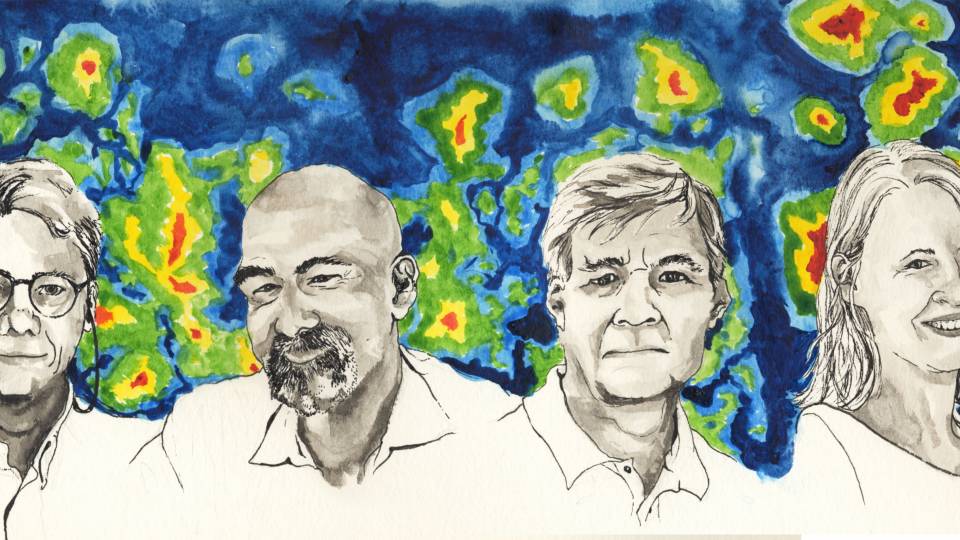Scientists peering back to the oldest light in the universe have new evidence for what happened within its first trillionth of a second, when the universe grew from submicroscopic to astronomical size in far less than a wink of the eye.
Using new data from a NASA satellite, scientists have the best evidence yet to support a scenario known as "inflation," in which the universe underwent a massive growth spurt 13.7 billion years ago to drive the period of expansion more commonly known as the Big Bang.
The evidence from the Wilkinson Microwave Anisotropy Probe (WMAP) satellite experiment -- a collaboration between NASA and several institutions, including Princeton -- was gathered over three years by observing remnants of the afterglow from the universe's first moments.
In 2003, NASA announced that the WMAP satellite had produced a detailed picture of the infant universe by measuring fluctuations in temperature of the afterglow -- answering many longstanding questions about the universe's age, composition and development. The WMAP team has built upon those results with a new measurement of the faint glare from the afterglow to obtain clues about the universe's first moments, when the seeds were sown for the formation of the first stars 400 million years later.
"This is brand new territory," said Princeton physicist Lyman Page. "We are quantifying the cosmos in a different way to open up a new window for understanding the universe in its earliest times. Researchers have long been working to test cosmological models for how the universe developed, but previously have not been able to collect data that could provide a picture this clear."
Charles Bennett, a Johns Hopkins University physicist and the WMAP principal investigator, said, "It amazes me that we can say anything about what transpired within the first trillionth of a second of the universe, but we can. We have never before been able to understand the infant universe with such precision."
The WMAP satellite is located 1 million miles from Earth -- four times farther away than the moon -- where it orbits the sun and maintains a straight line between the sun, Earth and satellite.
Over the past three years, the WMAP satellite collected data on a newly detected pattern, known as a polarization signal, in the glare of the afterglow. Measuring the polarization signal presented a major challenge for the WMAP team -- it is the weakest cosmological signal ever detected, less than a hundredth of the strength of the temperature signal reported three years ago.
The polarization signal enables researchers to study the patterns of faint light waves in the afterglow to obtain clues about the events in the first trillionth of a second of the universe. The researchers noted that the light waves vary in brightness, a key point that supports theories that the universe underwent a massive burst of inflation at its inception.
"The new data represent the most rigorous test of the current model of inflation, and it has passed with flying colors," said Princeton astrophysicist David Spergel, a WMAP team member.
Page said, "Through decades of observations, astronomers have been able to determine that the birth of the first generation of stars filled the universe with a sort of fog. Like the sun reflecting off the hood of a car, this fog reflects and polarizes the young universe's afterglow. It is exciting that we know enough to be able to look at the fog from the first stars and understand how the universe changed in the first trillionth of a second."
The new WMAP data, combined with other cosmology data, also support established theories on what has happened to matter and energy over the past 13.7 billion years since its inflation, according to the researchers. The result is a consistent picture of how our universe grew from microscopic quantum fluctuations to enable the formation of stars, planets and life, the researchers said.
According to that picture, only 4 percent of the universe is ordinary matter; another 22 percent is an unidentified dark matter, and 74 percent is a mysterious dark energy. That dark energy is now causing another growth spurt for the universe, the researchers said.
WMAP was launched on June 30, 2001. The WMAP team includes researchers at the Goddard Space Flight Center in Greenbelt, Md.; Johns Hopkins; Princeton; the Canadian Institute of Theoretical Astrophysics in Toronto; the University of Texas-Austin; Cornell University; the University of Chicago; Brown University; the University of British Columbia; the University of Pennsylvania; and the University of California-Los Angeles.
NASA named the satellite in honor of Princeton physicist David Wilkinson, a founding member of the project team who died in September 2002. A number of Princeton researchers also have contributed to the project, including senior research staff scientist Norman Jarosik, a founding member of the team who has played a major role in the construction of the WMAP satellite and the data analysis.
The newest WMAP results have been submitted to the Astrophysical Journal and are available on the WMAP Web site.

